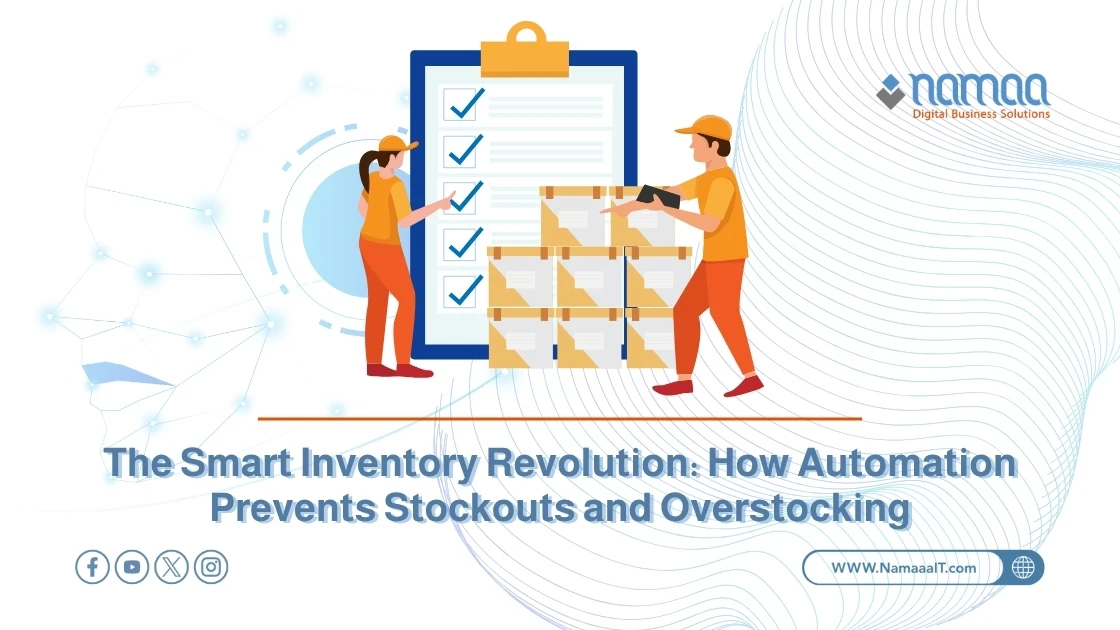In today’s business landscape, inventory management errors have become more costly than ever. Stockouts damage company reputations and lead to lost sales opportunities, while overstocking wastes money and takes up valuable space. Enter inventory automation—a smart solution that transforms inventory management from a burdensome task into a precise, streamlined process. In this article, we explore how the smart inventory revolution helps companies reduce waste, ensure constant product availability, and strike the perfect balance between supply and demand without the headaches of manual tracking.
The Importance of Inventory Automation in the Digital Commerce Era
With the rapid growth of digital commerce, inventory management has become a cornerstone of competitive edge and operational efficiency. Today’s e-commerce depends on fast delivery and accurate product availability—where automation plays a vital role.
Automation enables real-time updates to inventory levels when orders are fulfilled or new shipments arrive. This reduces reliance on manual counting and minimizes printing or input errors. According to recent statistics, automation tools can reduce stockouts by around 30% and increase operational efficiency by up to 50%.
This translates into salvaged sales opportunities, higher order fulfillment speed and quality, and more accurate planning through integration with ERP and WMS systems. Ultimately, this leads to better customer service, cost savings, and reliable future planning—all based on high-precision data. The result is a stable, seamless digital commerce experience, minimizing the financial risks caused by excess or insufficient inventory.
Core Automation Technologies: RFID, Barcodes, and Sensors
At the heart of inventory automation lie three essential technologies: barcodes, RFID, and smart sensors. Traditional barcodes remain the most common due to their ease of use and low cost, though they require direct line-of-sight scanning, limiting their speed in high-volume inventory checks.
In contrast, RFID technology allows fast scanning of large quantities without direct visibility, enabling semi-automated inventory processes and enhanced stock visibility. Sensors—especially useful in sensitive environments like warehouses or retail stores—monitor weight, temperature, and humidity, providing instant automated updates when changes occur.
Combining these technologies with automation enables continuous inventory monitoring and more frequent, accurate updates than manual counting. It reduces human error and allows for precise tracking from supplier to customer.
The Role of IoT in Real-Time Inventory Monitoring
The Internet of Things (IoT) amplifies inventory automation by creating a connected network of devices that enables real-time inventory monitoring. Manufacturers install smart sensors and self-regulating shelves equipped with Wi-Fi or Bluetooth to track product movement or depletion.
This instant data feeds inventory systems in real-time, triggering low-stock alerts or even automatic replenishment orders. Smart shelves use product weight to detect item presence without manual scans.
Beyond speed and efficiency, IoT provides detailed tracking of inventory within the warehouse, reducing waste and helping optimize space and resource planning. Companies that embrace these technologies enjoy significant cost savings and reduced time spent on daily stock checks and maintenance.
Artificial Intelligence and Demand Forecasting
Artificial intelligence (AI) is a game-changer in inventory management—especially for demand forecasting. Instead of relying solely on fixed rules and historical data, AI analyzes a variety of inputs including customer behavior, seasonality, economic factors, and external influences to create accurate predictive models.
The result: fewer forecasting errors, lower risks of overstocking or running out of stock. Some businesses have already seen real-world benefits. For example, AI-driven solutions in the consumer goods sector have reduced safety stock by up to 20% without impacting product availability. Retail giants like Target and Walmart use predictive systems to significantly reduce lost sales opportunities.
Smart automation through AI also enables proactive restocking, where systems are triggered to reorder in advance of expected demand spikes—keeping businesses agile and ready for market shifts.
Fully vs. Semi-Automated Inventory Systems
Not every business requires a massive investment in full automation. Semi-automated systems combine essential automation with a continued human role. Full automation handles 100% of warehousing, transport, and inventory processes, offering unmatched speed and accuracy—but requires high investment and advanced setups like AS/RS systems and AGVs (automated guided vehicles).
On the other hand, semi-automated setups integrate technology with manual oversight—for example, barcode systems where workers complete tasks or smart platforms supporting packaging with human monitoring. This is ideal for companies with limited budgets or those needing high production flexibility with a decent level of automation.
While semi-automation lowers upfront and maintenance costs, it still involves some human error risk. Full automation requires robust infrastructure and specialized maintenance teams.
Track-and-Trace Technology in Inventory and Supply Chain
Track-and-trace technology combines smart tools and real-time product tracking across the supply chain, making it essential for sensitive industries like pharmaceuticals. Notable systems such as Sepasoft and HCLTech use RFID and sensors to monitor items from production to delivery—logging every transaction digitally, eliminating the need for paperwork.
This structure enables instant detection of errors or deviations and facilitates real-time recall or incident analysis. When integrated with ERP/SCM systems, this tracking enhances inventory control, ensures compliance, and increases supply chain transparency for both customers and regulators. Ultimately, this reduces waste, improves risk management, and builds trust in secure product traceability.
Best Practices for Implementing Inventory Automation
Investing in technology alone isn't enough—adopting best practices is crucial to ensuring success and ROI. The first step is clearly defining goals: are you aiming to reduce overstocking, speed up audits, improve data accuracy, or all of the above? Clear answers help determine the right tools and software.
Another key practice is conducting a thorough assessment of the current inventory situation—identifying gaps, turnover rates, and waste zones. This serves as a baseline for evaluating automation performance later. Experts recommend gradual implementation, especially for mid-sized companies or those with limited infrastructure: start by automating core processes like stocktaking or shipment tracking, then scale up. This approach helps teams adapt and minimizes resistance to change.
Ongoing staff training is essential—smart automation is useless without skilled employees who can interpret its data and optimize results. It's also important to choose systems that integrate seamlessly with ERP, CRM, and other tools, ensuring unified databases and eliminating duplication or data mismatches.
Companies should continuously monitor automation performance using clear KPIs like order error rates and stockout frequencies, and adjust strategies in real time when needed. Following these steps turns automation from a costly tech investment into a powerful tool for sustainable growth and strong market competitiveness.
FAQs
1) Is inventory automation suitable for all types of businesses?
Not all companies need full automation. Small businesses may benefit from simple tools like cloud-based inventory software before investing in robotics or expensive systems.
2) How does automation affect customer service?
Automation improves product availability accuracy and order fulfillment speed, reducing errors and increasing customer satisfaction with delivery and service quality.
3) What challenges do companies face when switching to automation?
Challenges include high initial costs, training requirements, employee resistance, and ensuring data security in connected systems.
4) How does automation support environmental sustainability?
Automation reduces inventory waste and limits energy usage in overstocking and excess transport, decreasing the carbon footprint and boosting resource efficiency.
5) Does automation require ongoing maintenance?
Yes, automated systems rely on hardware and software that must be regularly maintained and updated to ensure performance, data accuracy, and reporting reliability.
Summary
✅ Inventory automation reduces human error and product loss by up to 30%, improving order accuracy and lowering operating costs.
✅ Technologies like RFID, sensors, and barcodes speed up stocktaking by 50% over manual methods, offering instant inventory visibility.
✅ IoT enables real-time inventory monitoring and cuts restocking response time by 40% in smart warehouses.
✅ AI enhances demand forecasting, reducing safety stock by 20% without affecting product availability.
✅ Best practices in automation boost inventory efficiency, cutting waste by 25% and increasing ROI within 12–18 months of implementation.





.webp)



